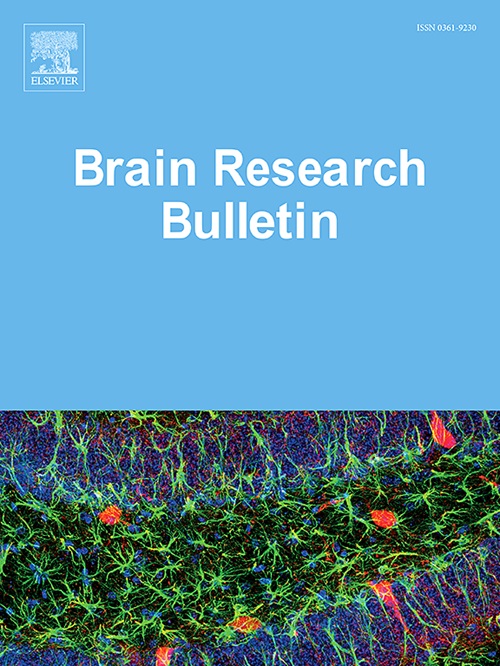Dynamics and concordance alterations of intrinsic brain activity indices in stroke-induced Broca’s aphasia varies based on first language: A resting-state fMRI analysis
IF 3.5
3区 医学
Q2 NEUROSCIENCES
引用次数: 0
Abstract
Objective
This study aimed to investigate the changes in intrinsic brain activity (IBA) among individuals with Broca aphasia (BA) after a stroke.
Methods
We collected information from 60 participants. The participants were categorized into four groups according to language (Uyghur and Chinese) and BA status (BA and healthy): Uyghur aphasia patients (UA), Uyghur healthy control subjects (UH), Chinese aphasia patients (CA), and Chinese healthy control subjects (CH). Each group comprised 15 individuals. The shifting dynamics and concordance of regional IBA indices were examined via sliding time-window analysis. A two-way analysis of variance (ANOVA) was conducted with the IBA indices to test for regions with interactions between language and BA status. Partial correlation analysis was employed to evaluate the relationships between various indices and language behaviors.
Results
Participants with head motion exceeding 3 mm translation or 3° rotation were excluded, leaving 9, 12, 13, and 15 participants in the UA, CA, UH, and CH groups, respectively. Seven IBA indices were activated in 16 brain regions in the four groups. In detail, two-way ANOVA revealed a significant interaction between language and BA status in four IBA dynamic indices (amplitude of low-frequency fluctuations (ALFF), Regional homogeneity (ReHo), degree centrality (DC), and functional connectivity (FC)) in 11 brain regions (P < 0.000). For the other three dynamic indices (fractional amplitude of low-frequency fluctuation (fALFF), Voxel-mirrored homotopic connectivity (VMHC), and Global signal connectivity (GSCorr)), no interaction was observed among the four groups. However, the main effect analysis of the BA state demonstrated significant differences across a total of six brain regions (P < 0.000). The concordance alterations in fALFF, ReHo, VMHC, DC, and GSCorr in the right calcarine fissure and the surrounding cortex were significantly lower in CA than in CH (P = 0.000), significantly higher in UA than in CA (P = 0.025), and significantly lower in UH than CH (P = 0.000).
Conclusion
In conclusion, alterations in IBA dynamics and concordance were observed in individuals from UA, UH, CA, and CH. These findings suggest that the IBA dynamic index varies across brain regions of BA patients with different local languages, providing a novel perspective for investigating brain alterations by analyzing temporal dynamics using rs-fMRI data.
方法 我们收集了 60 名参与者的信息。根据语言(维吾尔语和汉语)和布罗卡失语症状态(布罗卡失语症和健康)将参与者分为四组:维吾尔语失语症患者(UA)、维吾尔语健康对照组(UH)、汉语失语症患者(CA)和汉语健康对照组(CH)。每组 15 人。通过滑动时间窗分析,研究了区域 IBA 指数的变化动态和一致性。对 IBA 指数进行了双向方差分析(ANOVA),以检验语言和 BA 状态之间是否存在交互作用。结果排除了头部运动超过 3 毫米平移或 3° 旋转的参与者,UA、CA、UH 和 CH 组分别有 9、12、13 和 15 名参与者。四个组的 16 个脑区激活了 7 个 IBA 指数。具体而言,双向方差分析显示,在11个脑区的四个IBA动态指数(低频波动幅度(ALFF)、区域同质性(ReHo)、度中心性(DC)和功能连接性(FC))中,语言和BA状态之间存在显著的交互作用(P <0.000)。至于其他三个动态指数(低频波动分数振幅(fALFF)、体素镜像同位连通性(VMHC)和全局信号连通性(GSCorr)),四组之间没有观察到交互作用。然而,对 BA 状态的主效应分析表明,共有六个脑区存在显著差异(P < 0.000)。右心盏裂和周围皮层中的 fALFF、ReHo、VMHC、DC 和 GSCorr 的一致性改变在 CA 组显著低于 CH 组(P = 0.000),在 UA 组显著高于 CA 组(P = 0.025),在 UH 组显著低于 CH 组(P = 0.000)。这些研究结果表明,不同地方语言的 BA 患者脑区的 IBA 动态指数存在差异,这为利用 rs-fMRI 数据分析时间动态来研究脑部改变提供了一个新的视角。
本文章由计算机程序翻译,如有差异,请以英文原文为准。
求助全文
约1分钟内获得全文
求助全文
来源期刊

Brain Research Bulletin
医学-神经科学
CiteScore
6.90
自引率
2.60%
发文量
253
审稿时长
67 days
期刊介绍:
The Brain Research Bulletin (BRB) aims to publish novel work that advances our knowledge of molecular and cellular mechanisms that underlie neural network properties associated with behavior, cognition and other brain functions during neurodevelopment and in the adult. Although clinical research is out of the Journal''s scope, the BRB also aims to publish translation research that provides insight into biological mechanisms and processes associated with neurodegeneration mechanisms, neurological diseases and neuropsychiatric disorders. The Journal is especially interested in research using novel methodologies, such as optogenetics, multielectrode array recordings and life imaging in wild-type and genetically-modified animal models, with the goal to advance our understanding of how neurons, glia and networks function in vivo.
 求助内容:
求助内容: 应助结果提醒方式:
应助结果提醒方式:


